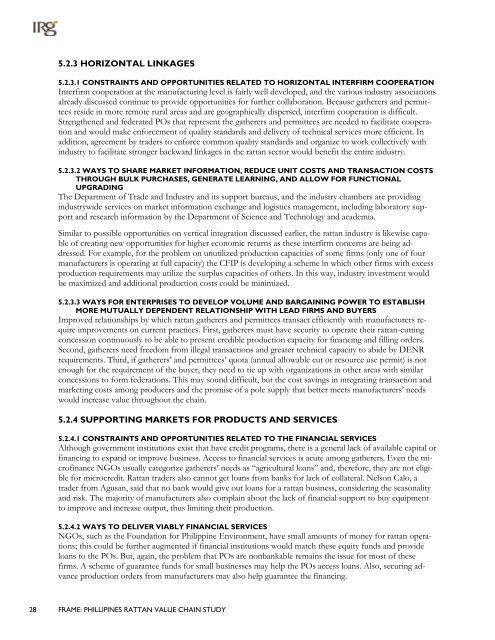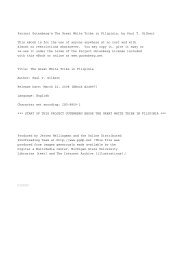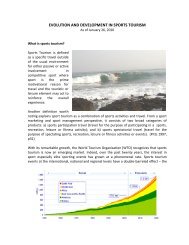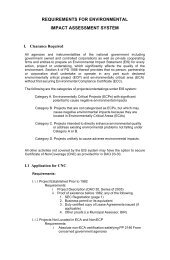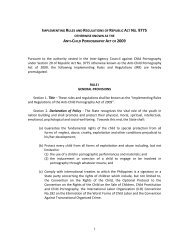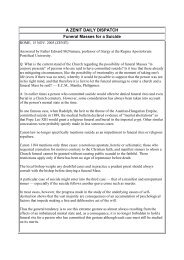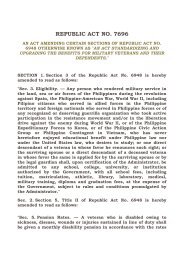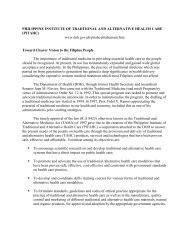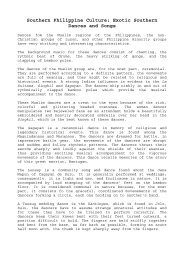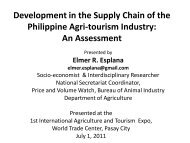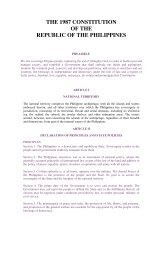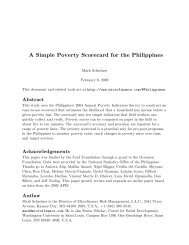PHILIPPINES RATTAN VALUE CHAIN STUDY - About the Philippines
PHILIPPINES RATTAN VALUE CHAIN STUDY - About the Philippines
PHILIPPINES RATTAN VALUE CHAIN STUDY - About the Philippines
You also want an ePaper? Increase the reach of your titles
YUMPU automatically turns print PDFs into web optimized ePapers that Google loves.
5.2.3 HORIZONTAL LINKAGES<br />
5.2.3.1 CONSTRAINTS AND OPPORTUNITIES RELATED TO HORIZONTAL INTERFIRM COOPERATION<br />
Interfirm cooperation at <strong>the</strong> manufacturing level is fairly well developed, and <strong>the</strong> various industry associations<br />
already discussed continue to provide opportunities for fur<strong>the</strong>r collaboration. Because ga<strong>the</strong>rers and permittees<br />
reside in more remote rural areas and are geographically dispersed, interfirm cooperation is difficult.<br />
Streng<strong>the</strong>ned and federated POs that represent <strong>the</strong> ga<strong>the</strong>rers and permittees are needed to facilitate cooperation<br />
and would make enforcement of quality standards and delivery of technical services more efficient. In<br />
addition, agreement by traders to enforce common quality standards and organize to work collectively with<br />
industry to facilitate stronger backward linkages in <strong>the</strong> rattan sector would benefit <strong>the</strong> entire industry.<br />
5.2.3.2 WAYS TO SHARE MARKET INFORMATION, REDUCE UNIT COSTS AND TRANSACTION COSTS<br />
THROUGH BULK PURCHASES, GENERATE LEARNING, AND ALLOW FOR FUNCTIONAL<br />
UPGRADING<br />
The Department of Trade and Industry and its support bureaus, and <strong>the</strong> industry chambers are providing<br />
industrywide services on market information exchange and logistics management, including laboratory support<br />
and research information by <strong>the</strong> Department of Science and Technology and academia.<br />
Similar to possible opportunities on vertical integration discussed earlier, <strong>the</strong> rattan industry is likewise capable<br />
of creating new opportunities for higher economic returns as <strong>the</strong>se interfirm concerns are being addressed.<br />
For example, for <strong>the</strong> problem on unutilized production capacities of some firms (only one of four<br />
manufacturers is operating at full capacity) <strong>the</strong> CFIP is developing a scheme in which o<strong>the</strong>r firms with excess<br />
production requirements may utilize <strong>the</strong> surplus capacities of o<strong>the</strong>rs. In this way, industry investment would<br />
be maximized and additional production costs could be minimized.<br />
5.2.3.3 WAYS FOR ENTERPRISES TO DEVELOP VOLUME AND BARGAINING POWER TO ESTABLISH<br />
MORE MUTUALLY DEPENDENT RELATIONSHIP WITH LEAD FIRMS AND BUYERS<br />
Improved relationships by which rattan ga<strong>the</strong>rers and permittees transact efficiently with manufacturers require<br />
improvements on current practices. First, ga<strong>the</strong>rers must have security to operate <strong>the</strong>ir rattan-cutting<br />
concession continuously to be able to present credible production capacity for financing and filling orders.<br />
Second, ga<strong>the</strong>rers need freedom from illegal transactions and greater technical capacity to abide by DENR<br />
requirements. Third, if ga<strong>the</strong>rers’ and permittees’ quota (annual allowable cut or resource use permit) is not<br />
enough for <strong>the</strong> requirement of <strong>the</strong> buyer, <strong>the</strong>y need to tie up with organizations in o<strong>the</strong>r areas with similar<br />
concessions to form federations. This may sound difficult, but <strong>the</strong> cost savings in integrating transaction and<br />
marketing costs among producers and <strong>the</strong> promise of a pole supply that better meets manufacturers’ needs<br />
would increase value throughout <strong>the</strong> chain.<br />
5.2.4 SUPPORTING MARKETS FOR PRODUCTS AND SERVICES<br />
5.2.4.1 CONSTRAINTS AND OPPORTUNITIES RELATED TO THE FINANCIAL SERVICES<br />
Although government institutions exist that have credit programs, <strong>the</strong>re is a general lack of available capital or<br />
financing to expand or improve business. Access to financial services is acute among ga<strong>the</strong>rers. Even <strong>the</strong> microfinance<br />
NGOs usually categorize ga<strong>the</strong>rers’ needs as “agricultural loans” and, <strong>the</strong>refore, <strong>the</strong>y are not eligible<br />
for microcredit. Rattan traders also cannot get loans from banks for lack of collateral. Nelson Calo, a<br />
trader from Agusan, said that no bank would give out loans for a rattan business, considering <strong>the</strong> seasonality<br />
and risk. The majority of manufacturers also complain about <strong>the</strong> lack of financial support to buy equipment<br />
to improve and increase output, thus limiting <strong>the</strong>ir production.<br />
5.2.4.2 WAYS TO DELIVER VIABLY FINANCIAL SERVICES<br />
NGOs, such as <strong>the</strong> Foundation for Philippine Environment, have small amounts of money for rattan operations;<br />
this could be fur<strong>the</strong>r augmented if financial institutions would match <strong>the</strong>se equity funds and provide<br />
loans to <strong>the</strong> POs. But, again, <strong>the</strong> problem that POs are nonbankable remains <strong>the</strong> issue for most of <strong>the</strong>se<br />
firms. A scheme of guarantee funds for small businesses may help <strong>the</strong> POs access loans. Also, securing advance<br />
production orders from manufacturers may also help guarantee <strong>the</strong> financing.<br />
28 FRAME: PHILLIPINES <strong>RATTAN</strong> <strong>VALUE</strong> <strong>CHAIN</strong> <strong>STUDY</strong>


